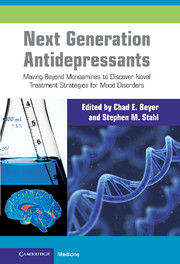 Next Generation Antidepressants
Next Generation Antidepressants Published online by Cambridge University Press: 19 October 2021
Remarkable progress notwithstanding, pharmacotherapy for depressive and related conditions, as well as pharmacological intervention of various other psychiatric and medical conditions, has typically ignored the magnitude and clinical relevance of the huge inter-individual variations in pharmacokinetics and pharmacodynamics. Such neglects lead to additional risks of severe and/or unpleasant side effects, medication non-adherence, prolonged periods of titration, suboptimal therapeutic responses, and treatment failures. Advances in pharmacogenomics and computer modeling technologies hold promises for achieving the goals of “personalized” (“individualized”) medicine. However, challenges abound for realizing such goals, including the packaging and interpretation of genotyping results, ethical considerations, financing, economy of scale, inertia against changes in medical practice (innovation diffusion), as well as other infrastructural and organizational issues related to the use of new information.
To save this book to your Kindle, first ensure [email protected] is added to your Approved Personal Document E-mail List under your Personal Document Settings on the Manage Your Content and Devices page of your Amazon account. Then enter the ‘name’ part of your Kindle email address below. Find out more about saving to your Kindle.
Note you can select to save to either the @free.kindle.com or @kindle.com variations. ‘@free.kindle.com’ emails are free but can only be saved to your device when it is connected to wi-fi. ‘@kindle.com’ emails can be delivered even when you are not connected to wi-fi, but note that service fees apply.
Find out more about the Kindle Personal Document Service.
To save content items to your account, please confirm that you agree to abide by our usage policies. If this is the first time you use this feature, you will be asked to authorise Cambridge Core to connect with your account. Find out more about saving content to Dropbox.
To save content items to your account, please confirm that you agree to abide by our usage policies. If this is the first time you use this feature, you will be asked to authorise Cambridge Core to connect with your account. Find out more about saving content to Google Drive.